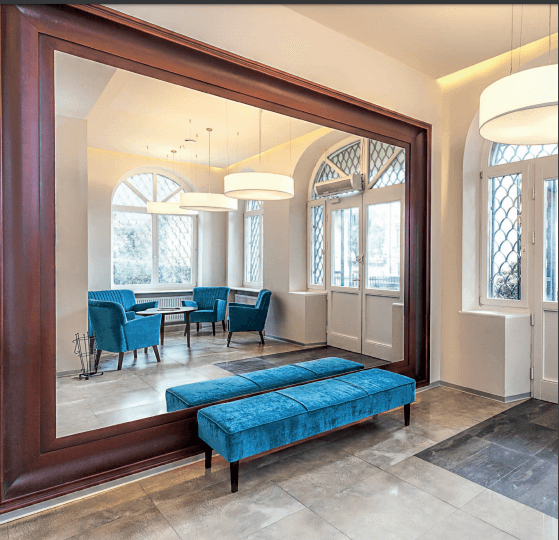For all of us, mirrors are fundamental grooming aids, but that is not the only benefit they provide. They also act as vital decoration tools that transform spaces and provide a sense of openness. You can set a lively and cheery mood in any room with the help of mirrors decorated tastefully. Mirrors have been a part of the human lifestyle since ancient times. The Greeks, Egyptians and Romans used handheld polished metal mirrors thousands of years ago. Mirrors made of glass came with the Venetians. They were the pioneers of casting glass into sheets and then silvering those sheets into mirror panes.
The Science behind Mirror Glass
Mirrors are nothing but clear glass panes metallically coated on one side with either aluminium or silver that renders them reflective. This process is called silvering. The metallic coat is usually applied in multiple layers on a float glass pane. The manufacturing process of mirror glass begins with smoothening and flattening the glass’ surface before applying metal coatings of uniform thickness on the inner side of the surface. These coatings have to be applied very carefully because if even one layer of the coating ends up being thicker than the rest, the mirror will either make you look fatter or thinner, or stretched out. If the silvering is too thin, you will be able to see through to the other side of the mirror. This is how one-sided mirrors are made.
Types of Mirrors
Mirrors are an affordable way to enhance the beauty of any space. They light up any room they are placed inside. Mirror glass is readily available in three major types. They are listed below for your quick reference –
Plane Mirrors –These are the most commonly used flat mirrors that reflect an object or a person situated in front of them in normal proportions and reversed from left to right. Plane mirrors are used by all of us daily in our bedrooms, bathrooms, living rooms, etc.
Convex Mirrors – These mirrors are spherical and bulge out slightly, distorting the image placed in front of them by making it look smaller. Convex mirrors are used in sunglasses, telescopes, roads with blind curves, etc.
Concave Mirrors – These mirrors are also spherical, however, unlike convex mirrors, they curve inward like a spoon. Convex mirrors make an image look larger, and are typically found in make-up and shaving mirrors, etc.
Varied Mirror Glass Applications
Mirror or mirror glass has a wealth of applications and they are not all aesthetic. Let us look at how mirrors in different shapes, sizes, thickness and brightness have diverse applications –
Ornamental Applications
Clear mirrors reflect a lot of light, to the extent of visually doubling the size of a room. This is a great benefit for people living in metropolises with limited square footage. You can place a couple of full-length mirrors on the walls of your cramped corridor. Mirrors also work beautifully as a masthead behind your bed, as opposed to putting up paintings that do nothing to open up space. Interior decorators love working with mirrors rightly so. You can yourself carry out a small experiment with mirrors to gauge its impact. Place a couple of floor-length mirrors at the entrance and other important corners of your home and see the space transform.
Safety Applications
Countless lives are made safer and more functional with the help of rear-view and side-view mirrors used in cars and two-wheelers that protect drivers, riders as well as passengers from accidents. Road safety is a major concern in India and automotive mirrors go a long way in making our streets safer. Security personnel also occasionally use mirrors to supervise hard to reach areas inside a parking lot or garage. Another safety application of mirror glass is in the form of lenses in your sunshades that protect you from retinal damage when you step out in the sun.
Textile Applications
Fashion designers and merchandisers use mirrors to gauge their designs from all angles simultaneously. This helps them assess the practicality and overall impact of the garment. All apparel retailers affix three-way mirrors inside trial rooms so that customers can accurately evaluate how well a piece of clothing fits them. Small mirror pieces are also stitched into clothing to give it a more ethnic appeal. Mirrors are cut into different shapes and stuck onto skirts, tops, dresses, etc. and are very popular among buyers.
Scientific Applications
Mirrors and lenses when combined are used in magnification technologies. For instance, all telescopes used to study celestial bodies, or keep an eye on new species of birds and animals require high-quality mirrors to function in tandem. Mirrors help scientists evaluate and investigate objects that are at a great distance and not visible to the naked eye.
The Bottom Line
Whatever your aesthetic or scientific goals may be, mirror glass will surely find an application within them. High-quality mirrors, especially made by leading glass manufacturers like AIS Glass have copper-free coatings, are resistant to corrosion and are eco-friendly. We also offer tinted mirrors that carry high optical clarity and are available in several colours, sizes and thicknesses. Our team of professionally-trained experts are equipped to provide you with end-to-end solutions with quick turnaround time. So, get in touch with us today!

